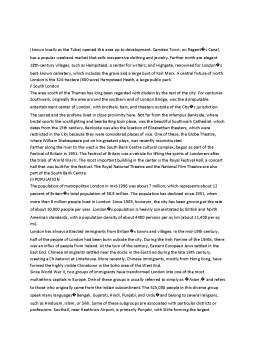Extras din referat
London (England), city, capital of the United Kingdom. London is situated in southeastern England along the Thames River. With a population of about 7 million, this vast metropolis is by far the largest city in Europe, a distinction it has maintained since the 17th century. In the 19th century it was the largest and most influential city in the world, the center of a large and prosperous overseas empire. Although it no longer ranks among the worldýs most populous cities, London is still one of the worldýs major financial and cultural capitals.
By European standards, London is physically spread out and dispersed, without a predominant focal point. It therefore defies easy general description, as the cityýs character is found in its diverse and distinct sections. Many of these sections began as separate villages, and today they maintain some of their individual identities. Londonýs image is partly defined by its past, as its major buildings and institutions represent 2000 years of community history. Its image is also the product of a new multiethnic mix of people and the creative impulse of the new popular culture of ýCool Britannia,ý a phrase Britainýs promoters conceived in the mid-1990s to portray Britain as modern and trendy.
Londonýs climate is generally mild and damp, although it can be erratic. This region is one of the driest parts of Britain, and the average annual rainfall is only 750 mm (30 in). However, the weather is generally cloudy, and some rain is liable to fall on half the days of the year. With a mean temperature in July of about 18° C (about 64° F), London has warmer summers than most of the island, although heat waves are infrequent and seldom last long. Temperatures rarely go above 26° C (78° F). Winters are relatively frosty, however, and the mean temperature in January is 4° C (40° F). Fog frequently develops in winter. In the past, foggy days were aggravated by smoke, resulting in London's traditional "pea-soupers." However, since the use of coal has significantly declined, these have largely disappeared.
II LONDON AND ITS METROPOLITAN AREA
Londonýs metropolitan area extends for more than 30 miles at its widest point, covering some 1610 sq km (620 sq mi). This vast urban territory is divided into 33 political unitsý32 boroughs and the City of London. At the core of this immense urban area is Central London. Most of Central London is located north of the Thames, on a gentle slope that rises to the north. It contains about 12 of the 33 political units, including the City of London, the City of Westminster, and districts in the West End. The City of London is the traditional heart of the city and stands as its own political unit. The City of Westminster is the seat of the national government. Much of the outer portion of this huge conglomeration of people and activities is made up of low-rise residential development.
A The City of London
The historical center of London is now a relatively small area still known as the City, which covers only about 2.6 sq km (about 1 sq mi). The City is capitalized, to distinguish it from the larger metropolis. This is where London began as a Roman colonial town around AD 50, at the point where the Romans built the first bridge in London. Today this area is one of the worldýs leading financial centers. Most of the financial activities are crowded along Threadneedle Street, near the intersection known as the Bank, which includes the huge Bank of England complex, the Royal Exchange, and the Stock Exchange. The permanent residential population of the City is now less than 6000, but about 350,000 commute here daily to work. The only large residential portion of the City is the Barbican Centre, a concrete complex of towers, parking garages, and pedestrian walkways located on the northern edge of the City. The Barbican was built to replace older buildings destroyed in World War II (1939-1945), when the Germans heavily bombed London.
Some of the Cityýs older elegance and significance remains despite the architectural havoc caused by the Blitz and postwar developers. The most prominent landmark is Saint Paulýs Cathedral, designed by English architect Christopher Wren to replace the original church, which was destroyed during the Great Fire of London in 1666. At the Cityýs eastern boundary is the Tower of London, where the Crown imprisoned many important figures. It was begun in the 11th century by the Norman invader, William the Conqueror, to awe a city he had not completely conquered. Successive monarchs added to the original, central White Tower, and built walls to enclose the 7-hectare (18-acre) site. Its function now is primarily ceremonial, although it still guards the Crown Jewels.
Preview document
Conținut arhivă zip
- About London.doc




















